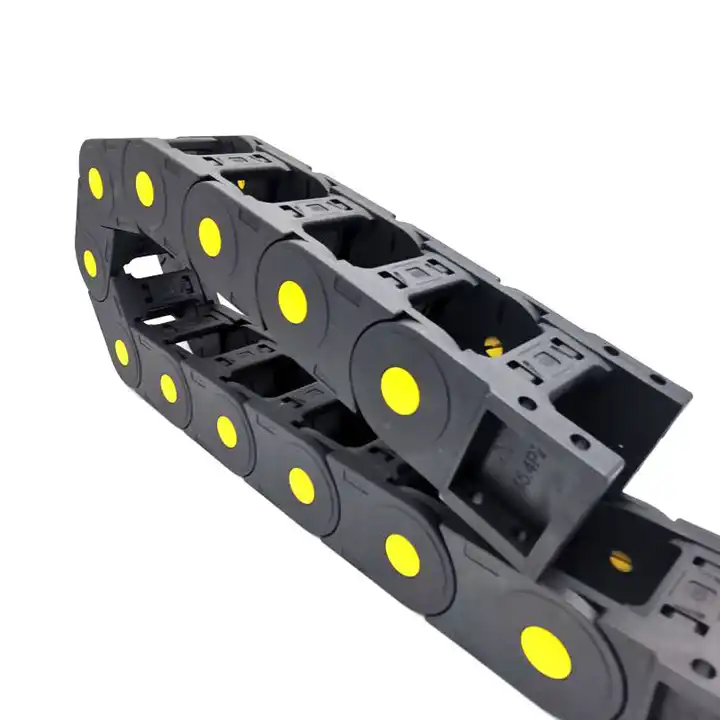Drag Chains
HIGH QUALITY HIGH PRECISE MANUFACTURER & SUPPLIER
What Is A Drag Chains?
A drag chain typically consists of a series of interconnected links or segments that form a flexible chain-like structure. These links are designed to enclose and guide cables and hoses, providing them with support and protection from external elements such as sharp edges, debris, or contaminants. The chain is engineered to be flexible, allowing it to bend and move in various directions while keeping the enclosed cables and hoses secure.
The primary purpose of a drag chain is to prevent damage to cables and hoses caused by excessive bending, abrasion, or exposure to hazards. By organizing and containing the cables and hoses within a drag chain, the risk of tangling, snagging, or premature wear is significantly reduced, thereby enhancing the lifespan and reliability of the connected components.

Drag Chains For Sale
-

CNC engraving machine parts open drag chain
-

CNC machine nylon open bridge flexible plastic line carrier plastic energy drag chain plastic cable drag chain
-

Machine tool engineering plastic drag chain bridge closed cable nylon chain
-

Nylon Flexible Drag Chain CNC Machine Cable Tray Tray Drag Chain
-

Openable bridge protective cable drag chain
-

plastic accessories cable nylon cable drag chain for CNC machine tools
How To Maintain The Drag Chains
Here are some general guidelines for maintaining drag chains:
Regular Inspection: Perform routine inspections of the drag chains to identify any signs of wear, damage, or misalignment.
Clean the Chains: Clean the drag chains regularly to remove dirt, debris, or contaminants that may accumulate on the surfaces.
Lubrication: Depending on the type of drag chain, lubrication may be necessary to ensure smooth movement.
Tension Adjustment: Over time, the tension of the drag chain may need to be adjusted to maintain proper alignment and prevent excessive sagging.
Repair or Replace Damaged Parts: If any segments or links of the drag chain are damaged or broken, they should be repaired or replaced promptly.

Application of Drag Chains
Industrial Machinery
Drag chains are extensively used in industrial machinery, such as CNC machines, milling machines, lathes, and machining centers. They protect and guide cables and hoses for power transmission, control signals, and fluid lines, allowing for reliable and safe operation.
Material Handling Systems
Drag chains are widely employed in material handling systems, including conveyor belts, automated warehouse systems, and assembly lines. They ensure the safe and organized movement of cables and hoses, minimizing the risk of interference or downtime.
Automotive Industry
In the automotive manufacturing process, drag chains are utilized in robotic welding systems, assembly lines, and other automated equipment. They protect and guide cables and hoses used for power, data transmission, and fluid lines, ensuring reliable operation and reducing downtime.
Robotics
Drag chains play a vital role in robotic systems by managing and protecting cables that provide power, communication, and control signals to robotic arms, grippers, and other moving components. They enable smooth movement and prevent cable damage or entanglement.
Packaging and Printing Machinery
Drag chains are used in packaging and printing machinery to manage the cables and hoses required for power supply, sensors, and control systems. They facilitate the efficient movement of these components while safeguarding them from damage.
Aerospace and Aviation
Drag chains find applications in the aerospace and aviation industries for managing and protecting cables in aircraft assembly, maintenance, and ground support equipment. They contribute to efficient cable routing and protection against harsh environmental conditions.
Drag Chains Advantage

Flexibility and Range of Motion
Drag chains are designed to be flexible, allowing them to bend and move in multiple directions. This flexibility accommodates the dynamic movements of machinery or equipment, ensuring that cables and hoses can follow and adapt to the range of motion without strain or damage.

Reduced Downtime
The protection and organization provided by drag chains help minimize cable failures and downtime. By preventing cable damage and interference, drag chains contribute to uninterrupted operation, increased productivity, and reduced maintenance and repair costs.

Noise and Vibration Damping
Drag chains with appropriate design and materials can help dampen noise and reduce vibration caused by cable movement. This feature is particularly beneficial in applications where noise reduction and operator comfort are important considerations.
How an Drag Chains works?
Here’s how drag chains work:
Structure: Drag chains typically consist of a series of interconnected links or segments that form a flexible chain-like structure.
Cable Insertion: The cables, hoses, or lines to be protected are inserted into the drag chain by opening the chain links or by accessing the crossbars of the chain.
Movement: As the machinery or equipment moves, the drag chain flexes and bends to accommodate the motion.
Protection: The drag chain shields the cables and hoses from external hazards such as sharp edges, abrasion, impact, chemicals, or excessive heat.
Cable Routing: Drag chains also facilitate proper cable routing.
Flexibility: Drag chains are designed to be flexible, allowing them to
bend and move in various directions.

Blog
WHY CHOOSE US?
We are one of the best drag chain manufacturers. We have exported our products to clients around the world and earned a good reputation because of our superior product quality and after-sales service. We warmly welcome customers both at home and abroad to contact us to negotiate business, exchange information, and cooperate with us!